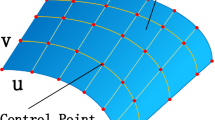Abstract
A machining feature can be regarded as the shape of the removal volume through a cutting process, which represents some manufacturing attributes of a part. Since the machining feature can play a crucial role in process planning, it is desirable to name machining features in such a way that a clear correlation between machining features and machining methods are reflected in the feature classification. However, most researches dealing with this topic do not clearly show the relationship between machining features and machining processes. On the other hand, no consensus on the feature classification method exists yet, which causes confusion when using the term “feature”. As a result, use of the features has not been very helpful in manufacturing preparation such as machining process selection. In this paper, classification methods of multi-axis machining features known in relevant literatures are studied firstly. Secondly, machining characteristics of various features are investigated to find out the relationship between machining features and machining methods. Thirdly, based on the machining methods of features, a logical classification scheme of multi-axis machining features is proposed. And finally, the proposed feature taxonomy is verified through applying to an example part with multi-axis machining features.
Similar content being viewed by others
Abbreviations
- D cr :
-
critical size of diameter in hole taken from the maximum available drill size
- W cr :
-
critical size of width in slot or step
References
Eum, K., Kang, M., Kim, G., Park, M. W., and Kim, J. K., “Ontology-based Modeling of Process Selection Knowledge for Machining Feature” Int. J. Precis. Eng. Manuf., Vol. 14, No. 10, pp. 1719–1726, 2013.
Kang, M., Han, J., and Moon, J., “An Approach for Interlinking Design and Process Planning” Journal of Materials Processing Technology, Vol. 139, No. 1, pp. 589–595, 2003.
ISO 10303-224, “Industrial Automation Systems and Integration — Product Data Representation and Exchange — Part 224: Application Protocol: Mechanical Product Definition for Process Planning using Machining Features” 2006.
Cayiroglu, I., “A New Method for Machining Feature Extracting of Objects using 2D Technical Drawings” Computer-Aided Design, Vol. 41, No. 12, pp. 1008–1019, 2009.
Bhandarkar, M.P. and Nagi, R., “STEP-based Feature Extraction from STEP Geometry for Agile Manufacturing” Computers in Industry, Vol. 41, No. 1, pp. 3–24, 2000.
Liu, Z. and Wang, L., “Sequencing of Interacting Prismatic Machining Features for Process Planning” Computers in Industry, Vol. 58, No. 4, pp. 295–303, 2007.
Lee, J. Y. and Kim, K., “A Feature-based Approach to Extracting Machining Features” Computer-Aided Design, Vol. 30, No. 13, pp. 1019–1035, 1998.
Han, J., Kang, M., and Choi, H., “STEP-based Feature Recognition for Manufacturing Cost Optimization” Computer-Aided Design, Vol. 33, No. 9, pp. 671–686, 2001.
Gindy, N. N. Z., “A Hierarchical Structure for Form Features” The International Journal of Production Research, Vol. 27, No. 12, pp. 2089–2103, 1989.
Zhang, C., Chan, K., and Chen, Y., “A Method for Recognising Feature Interactions and Feature Components within the Interactions” The International Journal of Advanced Manufacturing Technology, Vol. 13, No. 10, pp. 713–722, 1997.
Abu, R. and Md Tap, M., “Attribute based Feature Recognition for Machining Features” Jurnal Teknologi, Vol. 46, No. 1, pp. 87–103, 2012.
Shon, Y. T. and Park, M. W., “Recognition of Machining Features on Prismatic Components” Journal of Mechanical Science and Technology, Vol. 17, No. 6, pp. 1412–1422, 1993.
Xu, X. and Hinduja, S., “Recognition of Rough Machining Features in 21/2D Components” Computer-Aided Design, Vol. 30, No. 7, pp. 503–516, 1998.
Gao, J. X. and Huang, X. X., “Product and Manufacturing Capability Modelling in an Integrated CAD/Process Planning Environment” The International Journal of Advanced Manufacturing Technology, Vol. 11, No. 1, pp. 43–51, 1996.
Kim, G. H., Kang, S. K., and Eum, K., “A Study on Classification of Multi-Axis Machining Features” Proc. of the Korean Society of Manufacturing Technology, Vol. 11, pp. 162–163, 2011.
Author information
Authors and Affiliations
Corresponding author
Rights and permissions
About this article
Cite this article
Kang, M., Kim, G., Eum, K. et al. A classification of multi-axis features based on manufacturing process. Int. J. Precis. Eng. Manuf. 15, 1255–1263 (2014). https://doi.org/10.1007/s12541-014-0465-z
Received:
Revised:
Accepted:
Published:
Issue Date:
DOI: https://doi.org/10.1007/s12541-014-0465-z




